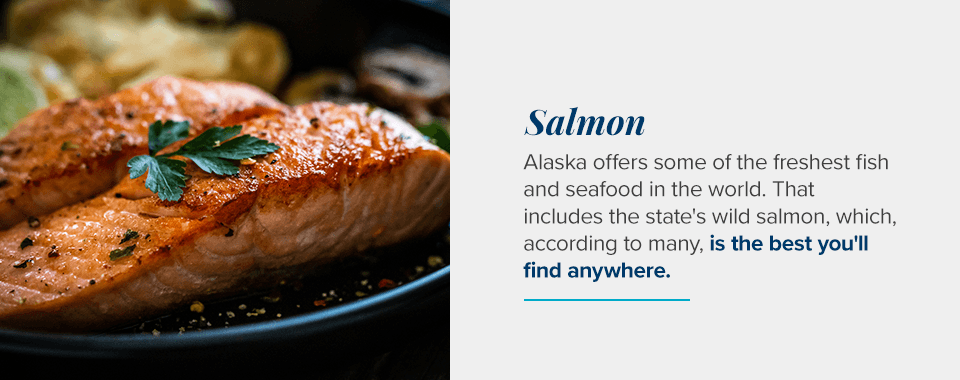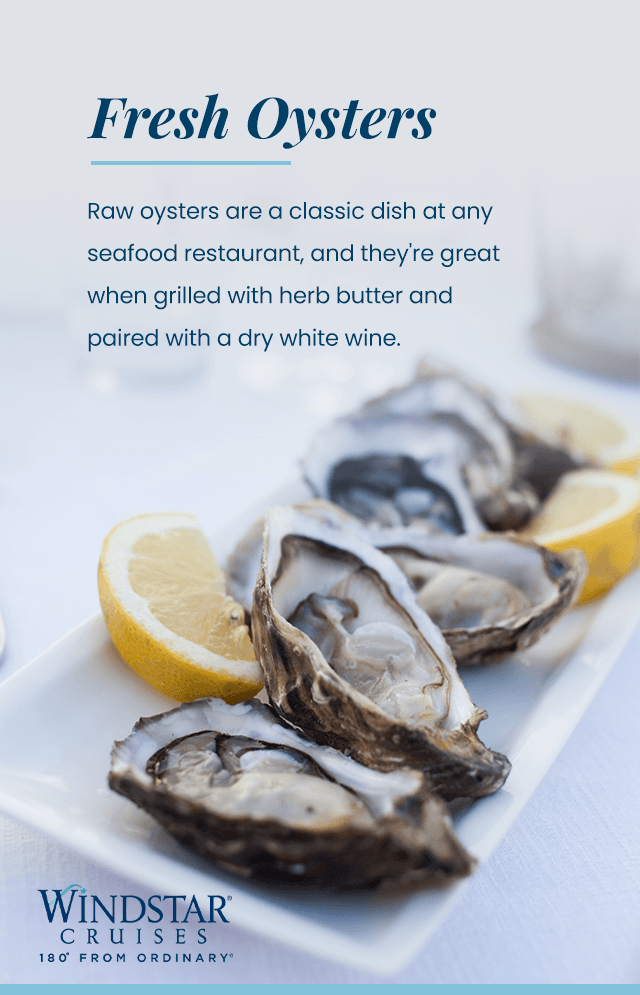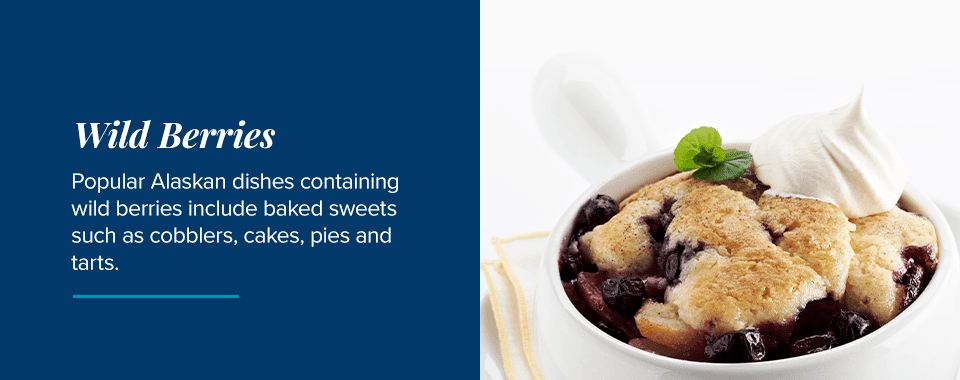
Fittingly nicknamed the Last Frontier, Alaska draws outdoorsy travelers from all over the country — and the world. The 49th state is home to diverse wildlife, vast forests, rich history and, of course, delicious food. From freshly caught fish to traditional delicacies, the state’s wild nature is infused into every element of its local cuisine.
Here are the most popular dishes in Alaska you need to try on your next cruise.
In This Article
- Salmon
- Halibut
- King Crab
- More Crab
- Fresh Oysters
- Reindeer Sausage
- Fry Bread
- Sourdough
- Wild Berries
- Spruce Tips
- Akutaq
- Muktuk
- Explore the Flavors of Alaska With Windstar Cruises
1. Salmon
Thanks to stringent government regulations, Alaska offers some of the freshest fish and seafood in the world. That includes the state’s wild salmon, which, according to many, is the best you’ll find anywhere.
Different varieties of salmon are in season throughout the year:
- Chinook: Also called king salmon, chinook is the largest species of Pacific salmon. A typical king salmon measures up to 3 feet long and weighs more than 30 pounds — due to their size, they’re the most expensive salmon on the list. These fish are renowned for their strong flavor and tender, bright-red flesh that’s delectable when grilled. The king salmon season peaks around June, but some restaurants will keep it on the menu into early fall.
- Sockeye: Sockeye salmon is Alaska’s most commercially important salmon species. Its rich flavor and firm red flesh make it an excellent fish for grilling, baking, searing, poaching and smoking. Alaskans often use leftover sockeye in soups and fish cakes. They’re in season from June to August and peak in July.
- Coho: The coho salmon season comes later in the year than both chinook and sockeye, making it the most sought-after salmon from August to September. Those who prefer more subtle flavors say it hits the sweet spot of taste and texture. It has a distinctive yet delicate flavor and orange-red flesh that’s perfect for grilling, baking and poaching.
When visiting the Last Frontier, anything containing salmon is worth a try. Pair your fish with a full-bodied white wine or light red to really savor the experience. Salmon’s bold flavor also goes well with white beer or saison, which you can find in one of the state’s many craft breweries.

2. Halibut
This bottom-dwelling flatfish is the largest of its kind, with the biggest catches weighing more than 500 pounds. Its white, flaky meat has a subtle flavor similar to flounder and tilapia — the halibut’s much smaller relatives. However, halibut is firmer and does better on the grill than other flatfish. But it doesn’t just taste great. A lean fish, halibut is a source of high-quality protein and micronutrients, including selenium, omega-3s and magnesium.
Halibut can be baked, grilled, broiled, steamed and poached. Due to its delicate taste, it works well with bolder flavors like citrus, pesto and ginger, but minimal seasoning lets the fish take center stage. Pair yours with a glass of white wine or a light ale for a luxurious meal.
3. King Crab
King crab is prized for its rich, meaty flesh and massive size. These 10-legged crustaceans spend their lives scavenging along the soft seafloor of the Bering Sea and neighboring waters. They’re low in fat and high in protein and omega-3 fatty acids, making them highly nutritious in addition to incredibly tasty.
Fisheries use traps to catch wild king crabs rather than trawls or other nets, which makes them far riskier to harvest than other varieties of seafood. This is part of the reason king crabs tend to be the most expensive items on the menu — the other part is their sheer size.
The most common ways to eat king crab are steamed or boiled, but you can also find crab meat in crab cakes, chowders and bisques. King crab legs might also come as a side to your entree.
There are three commercial species of king crab you might encounter on your travels:
- Red: True red king crab is the most coveted crab on the Alaskan market. These crabs are enormous at 11 inches wide with legs up to 5 feet long — the average male can weigh up to 24 pounds when mature. Its snow-white meat is sweet and succulent, especially in the legs and claws. Try it steamed with a side of melted butter for a classic Alaskan meal.
- Blue: Blue king crab turns red when cooked, so it’s sometimes marketed as red king crab. An average adult male can weigh up to 18 pounds and has enormous claws. Its meat tastes similar but slightly sweeter than that of red kings.
- Golden: The smallest king crab species, golden king crabs average around 5-8 pounds and contain less meat than the other species. Their flesh also has a much milder flavor, making them a good option for those who prefer something a little less fishy.
4. More Crab
Of course, Alaska offers other crab options for seafood lovers. The Dungeness crab is the most widely caught Alaskan crab. A true crab, the Dungeness has eight legs for movement and a single pair of claws in the front. It’s significantly smaller than the king crab, with the average male measuring 6.5 inches wide and weighing approximately 2 pounds. Dungeness crabs are typically eaten steamed, but they’re also delicious in crab cakes and salad.
The snow crab is one of Alaska’s most vital commercial catches. Found in the Bering Sea and the Gulf of Alaska, it’s much smaller than both the king crab and the Dungeness. Its tender meat is sweet and ever-so-slightly salty, making it a real treat in seafood salad and crab cakes.
5. Fresh Oysters
Alaskan oysters are considered to be some of the most delicious in the world, but they’re not native to the region. In fact, they don’t spawn naturally in Alaska at all — they must be imported from west coast hatcheries.
Oyster farmers keep their oysters in hanging baskets that never touch the ocean floor, which prevents the oysters from becoming impregnated with sand and growing pearls. The cold water also slows the oysters’ sexual maturation, which means you’ll always get crisp, fresh oyster meat in Alaska.
Raw oysters are a classic dish at any seafood restaurant, and they’re great when grilled with herb butter and paired with a dry white wine.

6. Reindeer Sausage
Once sold exclusively in street stalls, reindeer sausage has become a staple of the Alaskan food culture. Domestic Alaskan reindeer is a species of caribou with ancestral ties to a herd of Siberian reindeer brought to the state in the late 19th century.
Reindeer sausage typically contains a mixture of reindeer meat and minced beef or pork — this blend helps dilute the reindeer’s strong gamey taste. It’s commonly served at breakfast with toast, eggs or pancakes. You’ll also find street vendors selling hot grilled reindeer dogs with a variety of topping options such as onions and cheese.
7. Fry Bread
You might have heard of fry bread in other regions of the U.S., but Alaska’s version is a little different. It traditionally contains flour, dry milk, yeast, water, salt and sweetener.
The dish has deep roots in Inuit history and has become one of many cultural dishes. Historians believe the dish was invented out of desperation after the U.S. government outlawed the Inuits’ traditional farming and hunting methods. Pressed for something to eat, the Inuits ingeniously combined their rations of flour, fat and sugar to create something edible.
Now, you can buy fry bread at special shops and stands throughout the state. Each establishment puts its own spin on the dish — some serve it with a sprinkle of cinnamon and sugar while others top it with jam made from locally picked wild berries.
8. Sourdough
While it has European roots, sourdough bread is a staple food in Alaska. In fact, it’s so ingrained in Alaskan food culture that longtime residents are affectionately nicknamed “sourdoughs.”
Sourdough started its journey to Alaska during the California Gold Rush of the late 1840s when pioneers brought it across the country with them. It then moved north during the Klondike Gold Rush of the 1890s.
The bread’s origins go back several millennia to an Ancient Egyptian method of leavening bread. The story begins with a sourdough starter, which is a fermented mix of yeast, flour, water and lactic acid bacteria. During the bread-making process, the starter helps ferment the sugars in the dough, which makes the bread rise and gives it its characteristic tangy flavor.
It’s often served in bread baskets at restaurants, but you can buy fresh loaves at local bakeries. You can also find it used in sandwiches, cinnamon rolls, pancakes and even cookies in cafes and breakfast joints.
9. Wild Berries
Alaskan wild berries ripen much later than berries from the rest of the United States. Different berries grow in each region, so keep an eye out if you’re interested in sampling them for yourself. As long as you’re on public land, you’re free to pick as many berries as you like. That said, it’s best to stay on the safe side while picking — ask a park ranger or another local official before eating any.
The following are safe for consumption:
- Blueberries: Just like blueberries in other regions, Alaskan blueberries are good to pick when they’re a light blue color and easily pop off the branch.
- Raspberries: Look for raspberries with a deep red color. Like blueberries, you’ll know it’s ripe when you can easily pull it from the bush.
- Lingonberries: Also known as low-bush cranberries, lingonberries are small, round red berries native to colder climates. The bush’s flowers are white and bell-shaped with oval leaves.
- Salmonberries: These look like raspberries but can also be bright orange, yellow or red. The salmonberry flower is bright pink with five petals and a yellow center.
- Cloudberries: Cloudberries look like thick amber-colored raspberries and sprout from the ends of single branches. They have a tart flavor when ripe, but overripe berries are sweet with a creamy, yogurt-like texture.
Popular Alaskan dishes containing wild berries include baked sweets such as cobblers, cakes, pies and tarts. You’ll also find wild berries used in jams, liqueurs, frozen desserts and sauces.

10. Spruce Tips
If you like the smell of pine trees, you should try spruce tips — the little green buds that grow at the ends of spruce tree branches in the spring. You can eat them right off the tree, but they can also be pickled, boiled or baked.
Spruce tips are tender with a bright, citrus flavor and resinous aftertaste. They make surprisingly versatile ingredients — you’re most likely to find them as a garnish on salads and entrees, but they can also be baked into bread and cookies, blended into sauces and even mixed into cocktails.
11. Akutaq
Nicknamed “Eskimo ice cream,” akutaq is a local Alaskan delicacy. Akutaq is a Yup’ik word that literally translates to “something mixed,” which is a fitting description. Traditional versions contain a blend of whipped animal fat, fish, caribou meat, berries, snow and seal oil. If you’re able to try the real thing, remember that every family has a different recipe, so you’re unlikely to get the same thing twice.
While the ingredients might sound off-putting to some, the dish’s high fat content made it easier for the Inuit people to withstand the extreme cold of the Alaskan wilderness — hunters commonly ate it for sustenance while away from home.
It’s hard to find in its most authentic form, but if a local gives you the chance to sample some, you absolutely should. Modern versions often swap out the raw animal fat for vegetable shortening and add sugar to sweeten it. You also might find something vaguely similar in an ice cream shop, but the real deal is worth the try.
12. Muktuk
When it comes to exotic Alaskan food, muktuk tops our list. Muktuk is a traditional Inuit food made from cuts of skin and blubber from bowhead whales. It can also come from beluga whales and narwhals if bowhead is unavailable.
Traditionally, it’s served raw, but it’s also sometimes pickled or deep-fried and served with soy sauce. If you take it raw, it’s quite pretty — the skin looks almost like a thin cut of marble with a glistening piece of white fat attached. Raw muktuk has an oily, nutty taste and a very chewy texture.
Buying and selling wild game meat is illegal in Alaska, so you’re unlikely to find muktuk unless you have a local connection. Regardless, it presents a fascinating look into the state’s indigenous culture and history. If you’d like to learn more about the state’s original inhabitants, consider stopping by a historical museum such as the Alaska Native Heritage Center in Anchorage or the University of Alaska Museum of the North (UAMN) in Fairbanks.
Explore the Flavors of Alaska With Windstar Cruises
Participating in the local food culture is essential to any travel experience, and Alaska offers one of the most diverse culinary landscapes in the United States.
If you’re thinking of visiting the 49th state, you can count on Windstar Cruises to bring you there. Our intimate cruise ships allow for a truly immersive cultural experience beyond the typical tourist stops — and that includes the food. From visiting a local market with your Windstar chef to sampling local fare on a shore excursion, you’ll be able to experience the best of Alaskan cuisine.
Request a call today for more information about our Alaska cruises. Our vacation planners are here to help you plan the trip of a lifetime.




















































